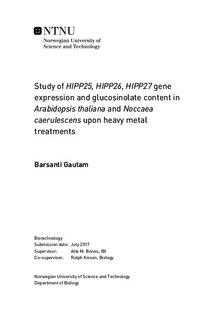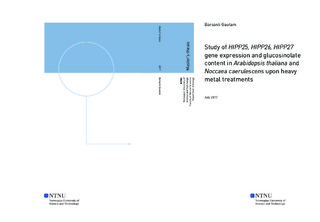| dc.description.abstract | Hyperaccumulator plant species accumulate exceedingly high concentrations of metals in aerial parts and are increasingly studied because of their potential for cleaning up land contaminated with heavy metals. One such hyperaccumulator, Noccaea caerulescens has been recognized as a model species for its remarkable Zn, Cd and Ni hyperaccumulation capacity and shares 88% sequence similarity with non-hyperaccumulator Arabidopsis thaliana in the coding region sequence. HIPPs (Heavy metal-associated isoprenylated plant proteins), are characterized by the presence of one or two HMA (Heavy metal associated) domain and a C terminal isoprenylation motif, present in both plants which have a possible role in hyperaccumulation. In the current study transcript levels of HIPP25 along with its closely related gene HIPP26 and HIPP27 were monitored in roots, leaves, flower and siliques of A. thaliana and root and leaves of N. caerulescens when exposed to Ni, Cu, Zn and Cd for 14 days (long term) and 24 hours (short term). Effect of metal treatment under long term condition was performed with two concentrations. Furthermore, the effect of these metal treatments on the HIPP25 protein level was also determined. Under long term treatments, in leaves of A. thaliana HIPP25 gene expression was higher with Cd, Zn and Cu exposure as compared to the control plants. HIPP25 gene in A. thaliana is possibly involved in the accumulation of Zn and Ni homeostasis as the expression of HIPP25 was higher in Zn treated leaves and lowered in the Ni treated leaves at both gene and protein level. In N. caerulescens, under short term treatments, Cu decreased HIPP25 and increased HIPP26 gene expression in roots. Under long term treatments, higher concentration of Ni reduced whereas lower concentration induced the HIPP26 gene expression in roots. From the comparative study on the protein level, HIPP25 proteins were expressed more in N. caerulescens than A. thaliana under both long term and short term treatments. Apart from this, changes in glucosinolate content in both plants exposed to Zn under both long term and short-term treatments were also monitored where the glucosinolate content in leaves of A. thaliana increased upon lower concentration under long term treatments whereas decreased upon higher concentration under both long and short-term treatments. In N. caerulescens under both concentrations in long term treatment, the glucosinolate content decreased and remains unchanged for short term treatments. | |

